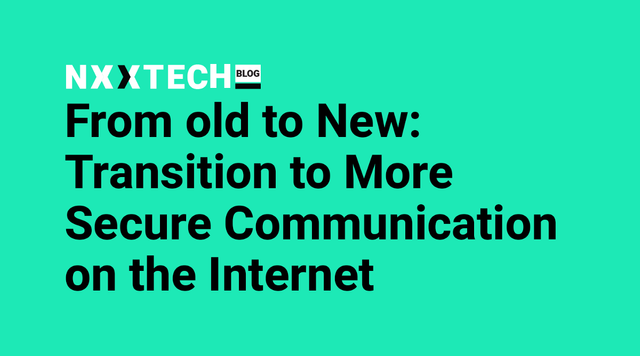From Old to New: Transition to More Secure Communication on the Internet
Secure communication is one of the cornerstones of a safe society. As Internet`s new technological backbone, blockchain innovates the ways we access global network services. How does Nxxtech fit into the new paradigm?

How does the Internet security work today?
Today, security is a part of Internet`s application level, in which we are using passwords, two factor authentication (2FA), secure connections, virtual private networks to connect devices and establish trust among them; and other implementations to achieve secure access. If you are curious to learn more on the architecture that is prevailing today, visit our previous blog post.
30 years into mass adoption of Internet, almost every device we own is smart, autonomous and connected. However, their providers rely heavily on server infrastructure and outdated security systems, meaning the IoT nework uses Internet˙s open ports to communicate and exchange valuable information. From the security perspective, the approach is full of loopholes.
explains Tomislav Mucic, cofounder & CEO of Netis Group and a visionary behind Nxxtech, enterprise-ready blockchain architecture.
That is the old way.
Same goal, different approach
Is there a one-fits-them all solution to enable devices from different manufacturers will be able to securely communicate on different levels and among themselves? We at Nxxtech believe there is. We are enabling the creation of a network (or networks) of trusted computers that can work outside of the trusted environment, on the blockchain. Our goal remains the same — we want to achieve secure communication of devices. However, we are taking a completely different approach. While in the “old ways” the security was a part of the application level, our way implements the security on the protocol level. Best example is virtual money. Now we can take the money out of the bank ledgers and put it on the protocol like blockchain of Bitcoin. We have effectively taken the money outside of the bank’s network and it’s still working. And, a similar concept applies for connected devices.
Building networks of identified things
With Nxxtech, communication is not done over open ports (like on the Internet), but over the blockchain. In other words, if we want to control the device, we can only do that over security layer of blockchain or smart contracts. No layer or no protocol that can be exploited can get a hold of it. The advantage of this approach is of course high security, as hacking the device is impossible, because to hack it, you need to hack the private key of the controlling device.
Nxxtech wishes to speed up the transformation of IoT into a network of interconnected devices which can communicate without human intervention. Today, no single networking technology fits them all. However, blockchain technology can help us to move from application layer of the Internet into a protocol layer, where each devices needs to present itself in order to communicate and execute orders. This is a paradigm shift that can unify the fragmented market and make sure the devices of different manufacturers can interact freely and safely for the user”,
adds Tomislav Mucic.
Decentralization of access control
IoT devices in Nxxtech network are the devices you implement, manage and control, and are not connected to the central servers. They do not even have open ports to be properly peer-to-peer controlled, they actually have their own security layer over the blockchain. This security layer also manages device identification and whitelisting. Who gets the control in this scenario? Only whitelisted addresses previously identified, users, or administrators, that have the corresponding private keys.

Communication layer over the blockchain
Blockchain in Nxxtech architecture is a private blockchain, not a public one. For one, devices are authenticated to each other using blockchain, and in case the log files must be stored, they’re stored on the proprietary storage layer over IPFS.
The other scenario for this kind of blockchain implementation is for a routing protocol — to connect different edge-to-edge home devices, for example to control a house, a car or a door. The routing protocol helps devices to find each other on the network. Once they do, they connect and establish their own proprietary link, and effectively take communication off the announcement network.
Blockchain in these scenarios is only used for smart contracts and for the announcements, or if needed, for tokens or other business process requirements. One of main advantages here is that scalability is not an issue, because all the communication is not on one network. This is the reason the whole concept translates into a proper edge-to-edge communication.
Follow our blog post series on IoT & blockchain as we will cover several issues Nxxtech has managed to solve to achieve transaction speed and seamless devices identification, paving our way towards standard adoption in IoT.
